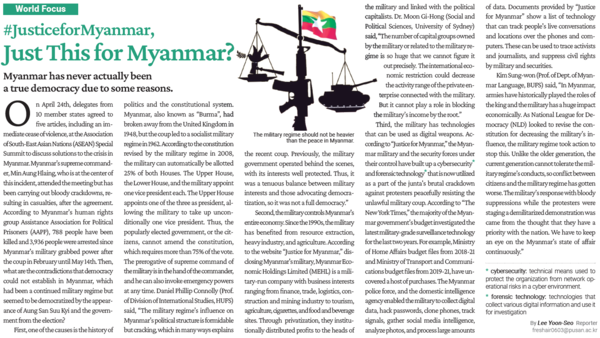Myanmar has never actually been a true democracy due to some reasons.

On April 24th, delegates from 10 member states agreed to five articles, including an immediate cease of violence, at the Association of South-East Asian Nations (ASEAN) Special Summit to discuss solutions to the crisis in Myanmar. Myanmar's supreme commander, Min Aung Hlaing, who is at the center of this incident, attended the meeting but has been carrying out bloody crackdowns, resulting in casualties, after the agreement. According to Myanmar's human rights group Assistance Association for Political Prisoners (AAPP), 788 people have been killed and 3,936 people were arrested since Myanmar's military grabbed power after the coup in February until May 14th. Then, what are the contradictions that democracy could not establish in Myanmar, which had been a continued military regime but seemed to be democratized by the appearance of Aung San Suu Kyi and the government from the election?
First, one of the causes is the history of politics and the constitutional system. Myanmar, also known as “Burma'', had broken away from the United Kingdom in 1948, but the coup led to a socialist military regime in 1962. According to the constitution revised by the military regime in 2008, the military can automatically be allotted 25% of both Houses. The Upper House, the Lower House, and the military appoint one vice president each. The Upper House appoints one of the three as president, allowing the military to take up unconditionally one vice president. Thus, the popularly elected government, or the citizens, cannot amend the constitution, which requires more than 75% of the vote. The prerogative of supreme command of the military is in the hand of the commander, and he can also invoke emergency powers at any time. Daniel Phillip Connolly (Prof. of Division of International Studies, HUFS) said, “The military regime’s influence on Myanmar’s political structure is formidable but cracking, which in many ways explains the recent coup. Previously, the military government operated behind the scenes, with its interests well protected. Thus, it was a tenuous balance between military interests and those advocating democratization, so it was not a full democracy.”
Second, the military controls Myanmar's entire economy. Since the 1990s, the military has benefited from resource extraction, heavy industry, and agriculture. According to the website “Justice for Myanmar,” disclosing Myanmar's military, Myanmar Economic Holdings Limited (MEHL) is a military-run company with business interests ranging from finance, trade, logistics, construction and mining industry to tourism, agriculture, cigarettes, and food and beverage sites. Through privatization, they institutionally distributed profits to the heads of the military and linked with the political capitalists. Dr. Moon Gi-Hong (Social and Political Sciences, University of Sydney) said, “The number of capital groups owned by the military or related to the military regime is so huge that we cannot figure it out precisely. The international economic restriction could decrease the activity range of the private enterprise connected with the military. But it cannot play a role in blocking the military’s income by the root.”
Third, the military has technologies that can be used as digital weapons. According to “Justice for Myanmar,” the Myanmar military and the security forces under their control have built up a cybersecurity* and forensic technology* that is now utilized as a part of the junta's brutal crackdown against protesters peacefully resisting the unlawful military coup. According to “The New York Times,” the majority of the Myanmar government’s budget investigated the latest military-grade surveillance technology for the last two years. For example, Ministry of Home Affairs budget files from 2018-21 and Ministry of Transport and Communications budget files from 2019-21, have uncovered a host of purchases. The Myanmar police force, and the domestic intelligence agency enabled the military to collect digital data, hack passwords, clone phones, track signals, gather social media intelligence, analyze photos, and process large amounts of data. Documents provided by “Justice for Myanmar” show a list of technology that can track people's live conversations and locations over the phones and computers. These can be used to trace activists and journalists, and suppress civil rights by military and securities.
Kim Sung-won (Prof. of Dept. of Myanmar Language, BUFS) said, “In Myanmar, armies have historically played the roles of the king and the military has a huge impact economically. As National League for Democracy (NLD) looked to revise the constitution for decreasing the military’s influence, the military regime took action to stop this. Unlike the older generation, the current generation cannot tolerate the military regime’s conducts, so conflict between citizens and the military regime has gotten worse. The military’s response with bloody suppressions while the protesters were staging a demilitarized demonstration was came from the thought that they have a priority with the nation. We have to keep an eye on the Myanmar’s state of affair continuously.”
*cybersecurity: technical means used to protect the organization from network operational risks in a cyber environment
*forensic technology: technologies that collect various digital information and use it for investigation

